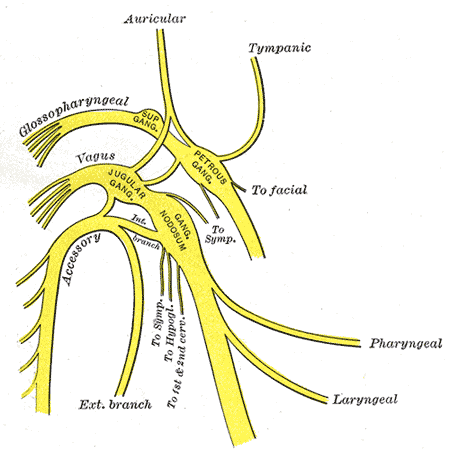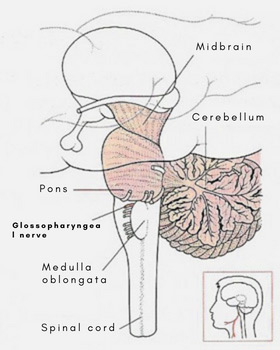glossopharyngeal nerve

The glossopharyngeal, vagus, and accessory nerves and their major branches. From Gray's Anatomy.
The glossopharyngeal nerve is the ninth cranial nerve. Together with the tenth (vagus) and eleventh (accessory) nerves, the glossopharyngeal nerve arises from the medulla oblongata and travels with the internal jugular vein, through the jugular foramen, from the cranium to the neck. It is concerned with sensation and taste in the pharynx and back of the tongue, and pierces the wall of the pharynx to supply the mucous membrane and activate secretion by the parotid gland.
 |
| The glossopharyngeal nerve arises from the medulla oblongata and branches to the lower jaw and the throat. |
The glossopharyngeal nerve is a mixed nerve. Its motor fibers supply the stylopharyngeus; its sensory fibers supply the mucous membrane of the middle ear, the pharynx, and posterior third of the tongue and also the carotid sinus; its secretory fibers reach the parotid gland by a circuitous route. The motor and secretory fibers arise in the medulla oblongata. The sensory fibers arise in two small ganglia placed on the trunk of the nerve in the jugular foramen, and their central branches end in the medulla.
Course and relations
The nerve is attached to the side of the upper end of the medulla oblongata. It leaves the skull through a notch on the margin of the jugular foramen below the internal auditory meatus – enclosed in its own sheath of dura mater; and, while in the jugular foramen, it communicates with neighboring nerves. In the neck, it first descends between the internal jugular vein and the internal carotid artery, deep to the styloid process and the stylopharyngeus. Next, appearing at the posterior border of the stylopharyngeus, it passes, with that muscle, between the internal and external carotid arteries; at the same time it curves forward across the superficial surface of the stylopharyngeus; and it then runs onward over the side of the pharynx to disappear under cover of the hyoglossus, where it breaks up into terminal branches for the tongue, the tonsil, the soft palate, and the epiglottis.
Branches
Besides the communicating and the terminal branches, the glossopharyngeal nerve gives off the tympanic nerve, the sty lo-pharyngeal branch, and the pharyngeal branches.
The tympanic nerve is a very slender nerve that arises immediately below the skull, It enters a small hole on the ridge between the carotid canal and jugular fossa, and ascends through a narrow canal to the tympanum. On the medial wall of the tympanum it breaks up to form the tympanic plexus. The plexus is joined by minute caroticotympanic nerves which arise in the carotid canal from the sympathetic plexus around the internal carotid artery. The tympanic plexus supplies the mucous membrane of the tympanum, the pharyngotympanic tube, the tympanic antrum, and the mastoid air-cells; and it sends a root to the lesser superficial petrosal nerve, by which the secretory fibers are sent on the first stage of their course to the parotid gland.
The nerve to the stylopharyngeus is a small twig which enters that muscle; the greater part of its fibers, however, are continued through the muscle to the mucous membrane of the pharynx.
The pharyngeal branches are: (1) One or two small twigs which perforate the superior constrictor to reach the mucous membrane of the pharynx. (2) A larger nerve which comes off higher up and passes with the pharyngeal branch of the vagus to the pharyngeal plexus; it divides into two or more branches, one of which joins a branch of the vagus to form the sinocarotid nerve for the supply of the carotid sinus and carotid body.


